Creamy Spring Risotto with Fresh Asparagus and Peas: An Easy & Flavorful Recipe
This creamy Spring Risotto with Asparagus and Peas is a truly delightful and simple recipe designed to elevate any springtime meal. Imagine tender, arborio rice cooked to perfection, infused with aromatic shallots and white wine, then folded with vibrant, crisp-tender asparagus and sweet, plump peas. It’s a harmonious blend of fresh flavors and comforting textures that embodies the essence of spring. Whether served as a elegant side dish, a light starter, or a hearty vegetarian main course, this risotto is incredibly versatile and pairs beautifully with a variety of proteins. It’s more than just a dish; it’s an experience that brings the fresh vibrancy of the season directly to your table, perfect for a cozy weeknight or a special gathering.
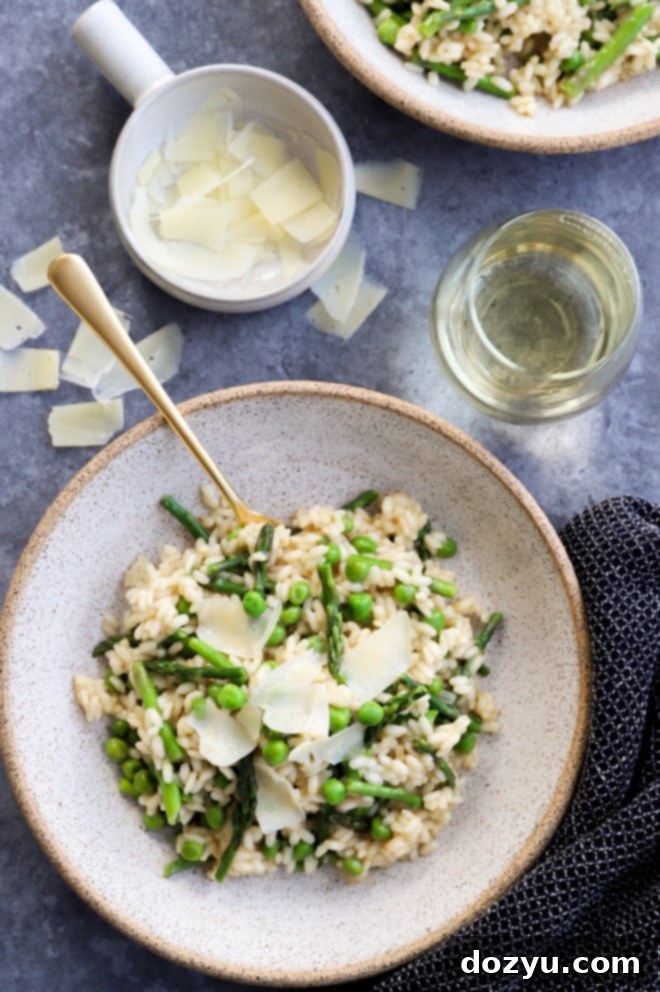
Table of Contents
Toggle
About This Risotto with Asparagus and Peas
For years, I’ve had a delightful tradition of creating a unique risotto recipe for each season. I managed to craft delicious versions for summer, fall, and winter, but somehow, my springtime creation always eluded me. Life often gets busy, and with an abundance of incredible spring vegetables to choose from – a vibrant palette of flavors – it was often difficult to settle on just one idea. But fear not, the wait is over!
I’m thrilled to finally present this light, bright, and utterly delicious springtime risotto, perfectly timed for the dawn of a new season. Risotto has always been a special, comforting meal for me, especially when I need to slow down and enjoy the process of cooking. It’s one of those rare dishes that truly requires your full attention in the kitchen. The frequent stirring isn’t just a chore; it’s a meditative act, allowing you to connect with the ingredients and appreciate the transformation happening in your pan. It’s a wonderful way to relax, unwind, and truly savor the joy of creating something delicious from scratch.
This recipe is also a fantastic way to introduce younger family members to cooking. Simple tasks like stirring become engaging and fun, turning meal preparation into a shared activity. Beyond its comforting nature, this spring risotto is incredibly versatile. It serves as a fantastic base for countless meal ideas and is super easy to customize. Feel free to incorporate other seasonal favorites like zucchini, mushrooms, or even snap peas. Don’t hesitate to experiment with fresh herbs from your garden to add an extra layer of flavor. You’ll find yourself returning to this recipe often, so make it truly your own!
Is Risotto Difficult to Make?
The intriguing truth about risotto is that it’s far less intimidating to make than many people imagine! Its reputation for being challenging often comes from a misconception. While it isn’t “hard” in terms of complex techniques, it absolutely demands one crucial ingredient: your time and undivided attention. This is not a dish you can rush; it rewards patience and presence. The entire process takes less than an hour, but you need to stay close to the stove, stirring consistently and adding liquid gradually. There are no shortcuts or magic tricks to speed up the cooking process (like cranking up the heat) without compromising the final creamy, luscious texture that defines a perfect risotto.
The constant stirring and slow addition of warm liquid are what encourage the arborio rice to release its starches, creating that signature rich, velvety consistency. If you’re a newcomer to the world of risotto, I highly recommend exploring my comprehensive how to make risotto guide. It walks you through every fundamental step, ensuring you master the simple yet essential techniques for crafting the best possible risotto. Once you grasp these basics, you’ll discover a newfound confidence, enabling you to effortlessly create seasonal risotto masterpieces throughout the year.

Essential Ingredients for Spring Risotto
Crafting a truly memorable risotto starts with selecting the right ingredients. Here’s a breakdown of what you’ll need for this vibrant spring dish:
- Stock: I typically opt for high-quality chicken stock to build a rich flavor base. However, if you’re aiming for a vegetarian risotto, vegetable stock is an excellent and equally flavorful alternative. Both chicken broth and vegetable broth can be used interchangeably with stock.
- Olive Oil: A good extra-virgin olive oil is all you need. Its fruity notes complement the other fresh flavors beautifully and provide the initial sautéing base.
- Asparagus: Fresh asparagus is absolutely key for this recipe! Look for bright green, firm spears. Remember to trim off the woody ends before cutting the spears into manageable 1-inch pieces.
- Peas: Frozen peas are perfectly acceptable and convenient, especially when fresh peas aren’t in season. If you are fortunate enough to find fresh peas, they’re a wonderful addition; just add them a little later in the cooking process, right at the very end, to preserve their delicate texture and sweetness.
- Butter: You can use either unsalted or salted butter for this recipe. Butter adds richness and helps create that signature creamy finish. Remember to season your risotto with salt progressively throughout the cooking process, allowing you to achieve your preferred level of seasoning.
- Aromatics: The combination of finely chopped shallots and minced garlic provides a nuanced, sweet, and pungent foundation that truly elevates the overall flavor profile of the risotto. Shallots are milder than onions, offering a more refined taste.
- Rice: Arborio rice is the undisputed star for risotto. This short-grain Italian rice is prized for its high starch content (amylopectin), which is crucial for releasing creaminess when stirred. While other rice types exist, this recipe is specifically developed for arborio, and long-grain rice would require different liquid ratios and wouldn’t yield the same creamy result.
- White Wine: A dry white wine, such as Sauvignon Blanc, Pinot Grigio, or a non-buttery Chardonnay, adds a crucial layer of acidity and depth to the risotto. This helps to deglaze the pan and introduces a complex flavor that is truly indispensable for authentic risotto.
- Parmesan Cheese: Always opt for freshly grated Parmesan cheese. Its sharp, nutty flavor and superior melting quality are far superior to pre-grated store-bought options. Keep a block on hand not only for grating but also save the rinds – they impart incredible depth when simmered in soups or stews!
Kitchen Tools for Perfect Risotto
Having the right tools can make all the difference in your risotto-making journey. For this recipe, I recommend a few essentials:
- To expertly prepare your fresh asparagus, a sharp chef’s knife and a sturdy cutting board are indispensable.
- For cooking the risotto itself, a high-sided skillet, often referred to as a risotto pan, is ideal. Its tall edges prevent rice and liquid from splashing out during vigorous stirring, and it offers ample surface area for even cooking. This type of pan is perfect even if you decide to double this spring risotto recipe.
- A reliable wooden spoon is a must-have. You’ll be doing a fair amount of stirring, and a wooden spoon is gentle on your pan and comfortable in your hand.
- Lastly, a small saucepan is essential for keeping your chicken or vegetable broth warm throughout the entire cooking process. This step is crucial for maintaining the rice’s temperature and ensuring a creamy result.
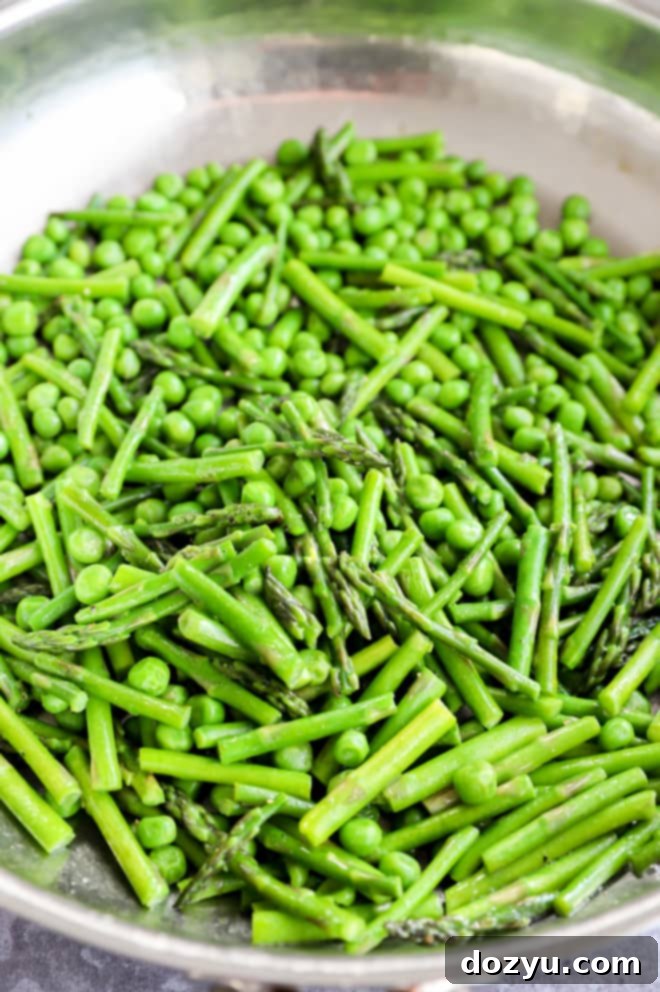
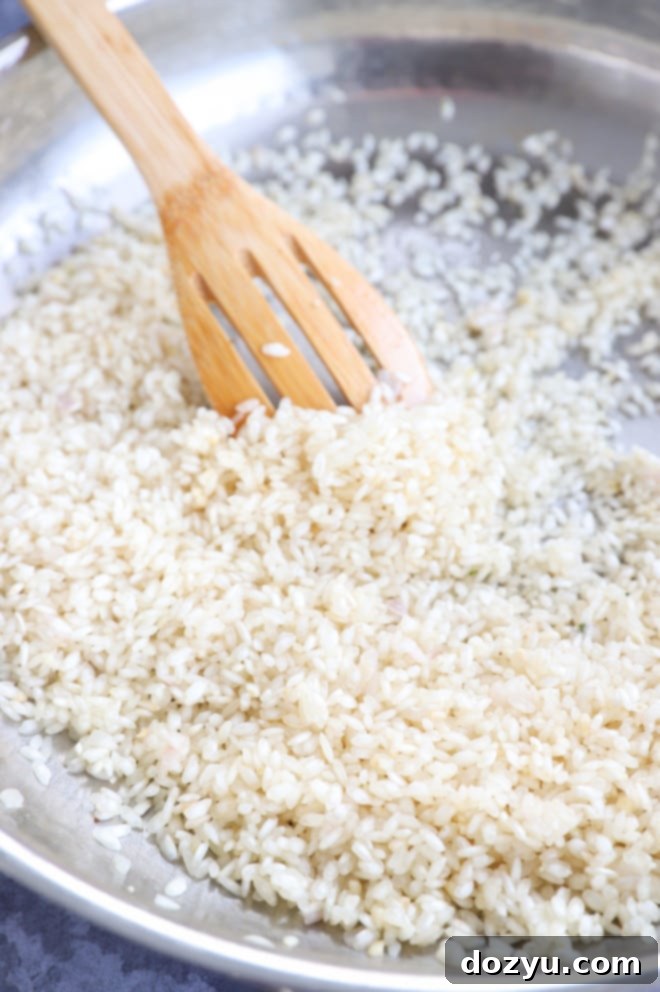
Step-by-Step: How to Make Asparagus and Pea Risotto
Follow these detailed steps to create a perfect, creamy spring risotto:
Prepare the Vegetables
First, ensure your chicken or vegetable stock is simmering gently in a small saucepan on the stove. Keep it covered and on low heat to maintain its warmth – this is a critical step for a smooth risotto. In a large skillet (a high-sided risotto skillet is ideal here), heat the olive oil over medium-low heat. Once shimmering, add your trimmed asparagus pieces, seasoning them lightly with salt and pepper. Cook them for 2 to 4 minutes, stirring occasionally, until they are tender-crisp. The exact cooking time will vary based on the thickness of your asparagus spears. Next, stir in the frozen peas and cook for just another minute or two, until they are fully defrosted and bright green. Once cooked, transfer these vibrant vegetables to a plate or bowl and set them aside.
Toast the Rice
Using the same skillet, melt two tablespoons of unsalted butter over medium heat. Add the finely chopped shallots and cook, stirring until they are softened and translucent, which typically takes about 2 to 3 minutes. Stir in the minced garlic and cook for just one more minute until it becomes fragrant – be careful not to burn it. Now, add the arborio rice to the skillet. Toast the rice, stirring constantly for about 2 minutes, until the edges of the grains become translucent and the center remains opaque. This toasting process, known as “tostatura,” is essential for developing a nutty flavor and helping the rice absorb liquid more evenly, preventing it from becoming mushy.
Gradually Cook and Stir
Pour in the white wine and allow it to simmer, stirring frequently, until it is almost completely evaporated. This deglazes the pan and imparts a wonderful depth of flavor. Next, ladle in approximately 1 cup of the hot stock. Cook, stirring continuously and patiently, until the stock has been fully absorbed by the rice. This constant stirring helps release the starches from the arborio rice, which is key to achieving that signature creamy consistency. Repeat this process: add 1 cup of warm stock at a time, stirring constantly until each addition is absorbed. Continue this for approximately 25 to 35 minutes total, or until the rice is tender but still has a slight bite (al dente). You may not need all the stock, so taste the rice after each addition to check for doneness.
The Finishing Touch
Once the rice has reached its ideal al dente texture, remove the skillet from the heat. Stir in the freshly grated Parmesan cheese and the remaining one tablespoon of butter until they are fully melted and beautifully incorporated. This final step, known as “mantecatura,” adds incredible richness and enhances the risotto’s creaminess. Season generously with salt and freshly ground black pepper to taste, adjusting as needed. Finally, gently fold in the reserved cooked asparagus and peas. Keep the risotto warm over very low heat until you’re ready to serve. For an elegant presentation, serve topped with additional shaved Parmesan cheese and a sprinkle of fresh herbs.

Pro Tips for Risotto Success
Making a truly exceptional risotto is all about paying attention to a few key details. Here are some pro tips to ensure your Asparagus and Pea Risotto turns out perfectly every time:
- Add a Touch of Citrus: To brighten up the dish and add a wonderful zing, incorporate a squeeze of fresh lemon juice right at the end of the cooking process. The acidity cuts through the richness and enhances the fresh spring flavors.
- Taste, Taste, Taste: This cannot be emphasized enough. Seasoning is a continuous process. Start by seasoning your vegetables, then taste the rice as it cooks, and finally, adjust the salt and freshly ground black pepper when all ingredients are incorporated. Proper seasoning truly makes flavors sing.
- Stay by the Stove: Risotto is a hands-on dish that thrives on your presence. Avoid leaving the stove unattended, especially during the crucial “cook and stir” phase. Consistent stirring is essential for releasing the rice’s starches and achieving that signature creaminess. Embrace this time as a meditative part of your cooking experience.
- High-Quality Ingredients Matter: Since risotto relies on relatively few ingredients, the quality of each component shines through. Use fresh, vibrant asparagus, good quality stock, and freshly grated Parmesan for the best possible flavor and texture.
More tasty risotto recipes to explore: Winter Roasted Vegetable Risotto | Bacon Butternut Squash Risotto | Summer Corn Risotto
Frequently Asked Questions About Risotto
Does the Stock Need to Be Warm?
Absolutely, yes! Keeping your stock warm on a separate burner is one of the most critical steps in making perfect risotto. Skipping this step can drastically impact your final dish. Adding cold stock to hot rice will immediately cool down the pan, shocking the rice and hindering its ability to release starches effectively. This can result in a longer cooking time and a less creamy, often gummy, risotto. Warm stock, on the other hand, maintains the rice’s temperature, promoting consistent cooking and the optimal release of starches, which is essential for that lusciously creamy texture.
What Kind of Rice is Best for Risotto?
This recipe, like most traditional risotto recipes, specifically calls for arborio rice. Arborio is a short-grain Italian rice known for its high amylopectin (starch) content. This starch is what creates the characteristic creamy texture when released through constant stirring and gradual liquid absorption. While long-grain rice can technically be used for some rice dishes, it has a different starch composition and requires a different liquid ratio, and it’s much harder to achieve that desired creamy consistency. For truly authentic and consistently delicious risotto, sticking with arborio rice is always the best choice.

How to Make This Risotto Vegetarian?
Transforming this delicious spring risotto into a vegetarian dish is incredibly simple! All you need to do is substitute chicken stock with an equal amount of good quality vegetable stock. This one simple swap makes the entire recipe vegetarian-friendly, perfect for a meatless main course or as a flavorful accompaniment to crispy tofu, a hearty mushroom steak, or your favorite plant-based protein.
Can I Skip the White Wine?
The white wine adds a wonderful layer of acidic brightness and complex flavor to the risotto, which I truly love. If you’re concerned about the alcohol content, rest assured that the alcohol cooks off almost entirely during the simmering process, leaving behind only its rich flavor. However, if you prefer to omit alcohol altogether, you can certainly do so. Simply replace the white wine with an equal amount of extra vegetable or chicken stock. While the flavor profile will be slightly different, it will still yield a delicious and creamy risotto.
Can This Risotto Be Made Ahead of Time?
Generally speaking, risotto is a dish best enjoyed immediately after it’s prepared, as its creamy texture is at its peak. I always recommend making it fresh if possible to savor its optimal consistency. However, if you find yourself with leftovers or need to prepare a component slightly in advance, the risotto will last in an airtight container in the refrigerator for up to 2 days. Be aware that the texture will firm up significantly once cooled. Detailed instructions on how to properly reheat it to restore some of its creaminess are provided below, just above the recipe card.
Need more inspiration for spring recipes? Check out my spring recipes page!
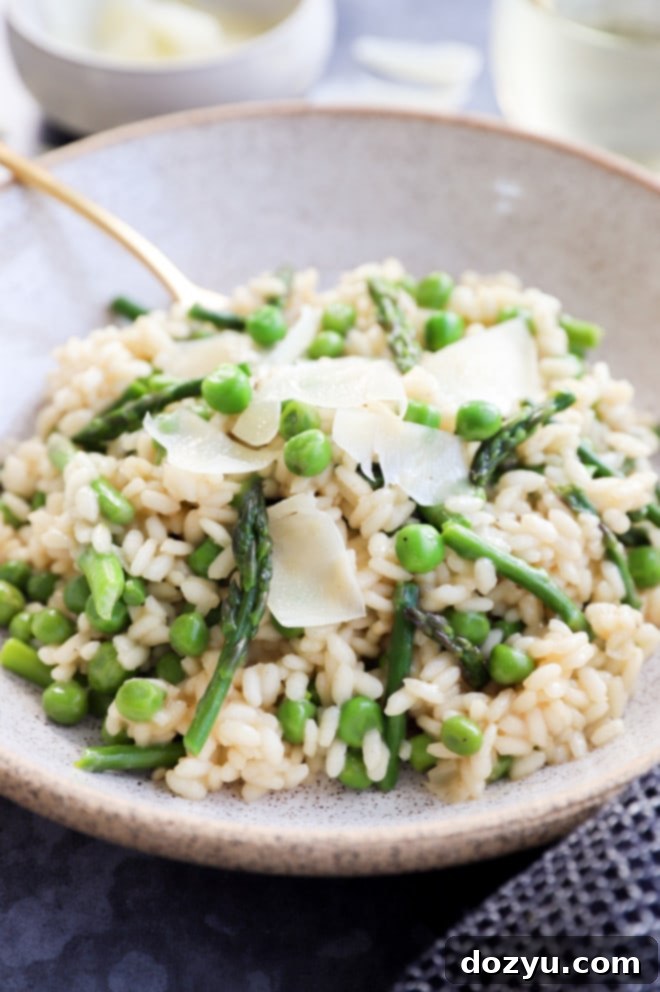
What to Serve with Spring Risotto
This creamy asparagus and pea risotto is incredibly versatile and can be enjoyed in many ways. It stands beautifully on its own as a fulfilling vegetarian main dish (especially when made with vegetable stock), or it can serve as an elegant and flavorful side to a variety of proteins. Given its lighter, brighter springtime profile, it pairs wonderfully with seafood, chicken, lamb, or pork. Don’t be afraid to serve it with a perfectly cooked steak either; the creamy texture and fresh flavors offer a delightful contrast.
To truly elevate this dish, consider garnishing it with crispy pieces of bacon or prosciutto in addition to the shaved Parmesan. The salty, savory crunch provides an exquisite textural and flavor counterpoint. A simple green salad with a light vinaigrette would also be a lovely accompaniment, offering a refreshing element.
Here are some delicious main dish ideas to pair with your risotto:
- Roasted chicken with white wine and fresh herbs is an effortless and aromatic pairing, conveniently roasting in the oven while your risotto simmers on the stove.
- For exceptional tenderness and flavor, try serving slices of this sous vide chicken thigh recipe directly over a bed of the creamy risotto.
- Break out your air fryer for these quick and succulent scallops with chive lemon butter. They cook in minutes and are a perfect match when gently placed atop a warm bowl of this spring risotto.
- An air fryer bacon-wrapped pork loin offers a delightful crispy exterior and juicy interior, making it a fantastic, savory counterpoint to the risotto.
- If you’re aiming to truly impress your guests, prepare this risotto as a sophisticated side for my herb-crusted rack of lamb with red wine sauce. It’s an ideal combination for any elegant spring dinner party or special occasion you have planned.
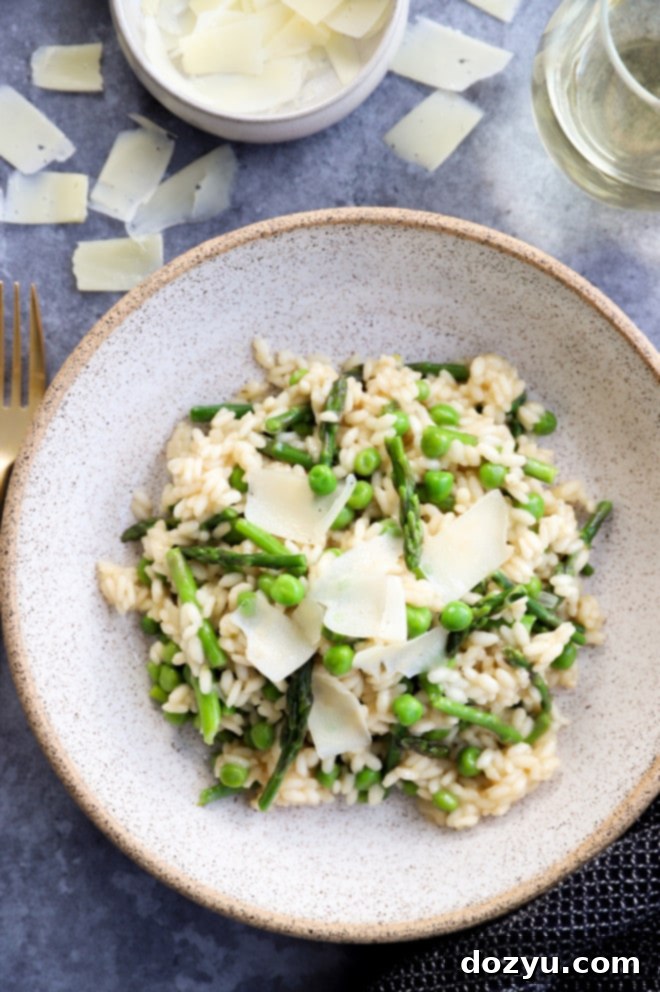
Storage and Reheating Instructions
While risotto is best enjoyed fresh, here’s how to handle any delicious leftovers:
- Store: Allow any leftover risotto to cool completely before transferring it to an airtight container. Store it in the refrigerator, where it will remain fresh for up to 2 days.
- Reheat: When ready to reheat, risotto can become quite firm and dry. To restore its creamy texture, add 1 tablespoon of unsalted butter and a splash of white wine or chicken/vegetable stock to the risotto. Microwave in 1-minute intervals, stirring after each, until heated through, approximately 3 minutes total. Continue adding small splashes of liquid as needed until it reaches your desired creamy consistency, ensuring it doesn’t dry out. Reheating on the stovetop over low heat with a bit of added liquid also works well.
- Freeze: Please, do not freeze risotto! The delicate texture of the cooked arborio rice breaks down significantly when frozen and thawed, resulting in a very unappealing, mushy consistency that simply doesn’t do the dish justice.
Finally, if you decide to make this creamy Asparagus and Pea Risotto recipe, please take a moment to give it a rating or leave a comment below! I genuinely love hearing about your cooking experiences and always make time to respond to every single comment. Feel free to ask any questions you might have about the recipe, too!
Oh, and don’t forget to tag me on Instagram if you share your culinary creations! Seeing these recipes come to life in your kitchens is truly my favorite thing, and it means the world to me!
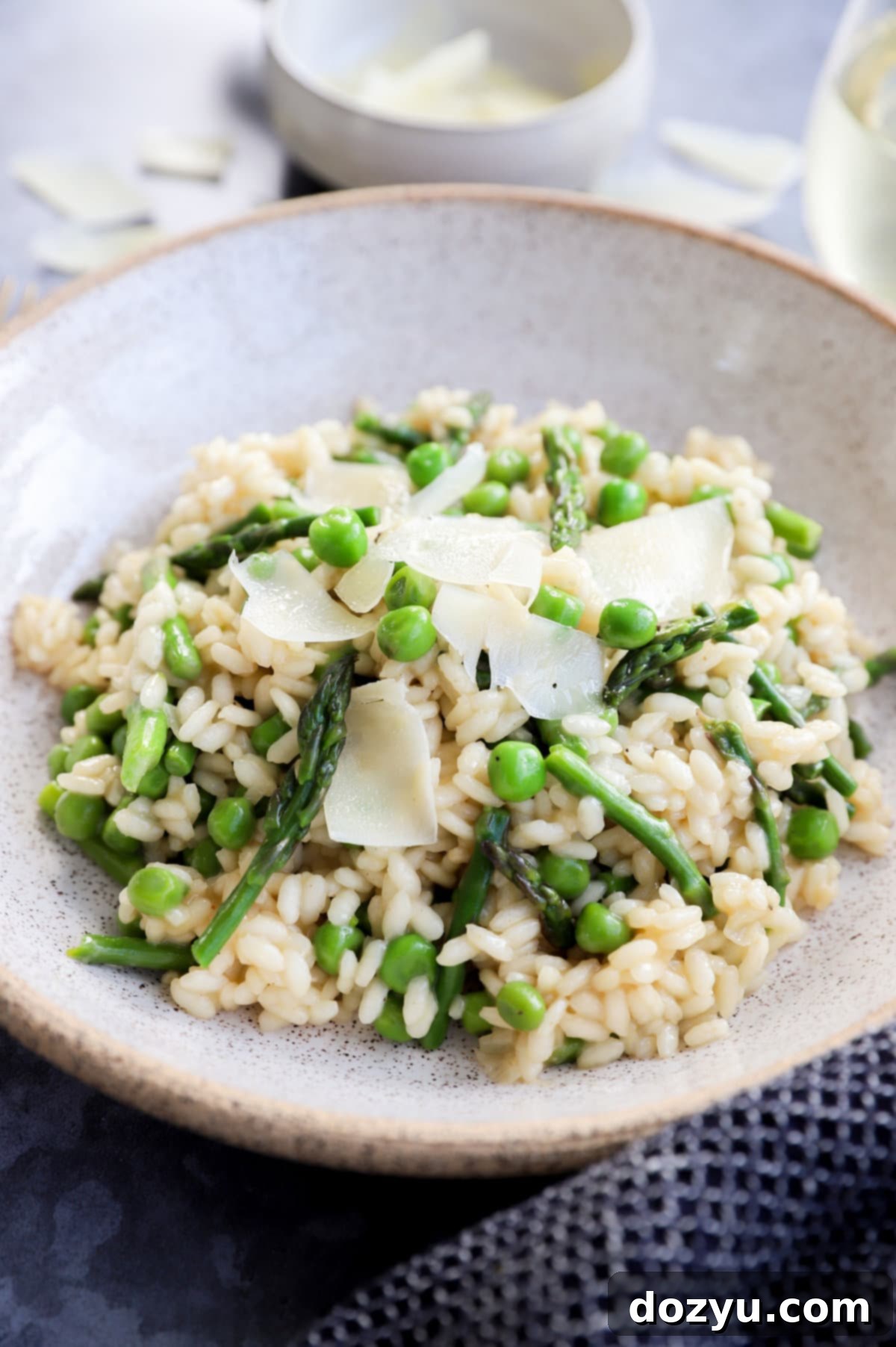
Risotto with Asparagus and Peas (Recipe Card)
5 minutes
50 minutes
55 minutes
4
prevent your screen from going dark
Equipment
-
Le Creuset Saucepan
-
Wooden Spoon & Scraper
-
Nonstick 12-Inch Skillet
Ingredients
-
2 to 3
cups
chicken or vegetable stock -
1
Tbsp
olive oil -
1
bunch asparagus
preferably thin, trimmed and cut into 1-in pieces -
1
cup
frozen peas -
3
Tbsp
unsalted butter
separated -
2
shallots
finely chopped -
2
garlic cloves
minced -
1 1/2
cups
arborio rice -
1
cup
white wine
I used a chardonnay -
1/4
cup
grated parmesan cheese
Instructions
-
In a small saucepan, bring the chicken or vegetable stock to a gentle simmer; cover and keep warm over low heat.
-
In a large skillet, heat olive oil over medium-low heat. Once hot, add asparagus and season with salt and pepper. Cook, stirring occasionally, until asparagus is crisp-tender, about 2 to 4 minutes (depending on the thickness of your asparagus spears). Add peas and continue to cook for about 1 minute, until the peas are defrosted and heated through. Transfer vegetables to a bowl or plate, set aside.
-
In the same pan, heat 2 Tbsp butter over medium heat. Add shallot, cooking until softened, about 2 to 3 minutes. Add the garlic and cook until fragrant, about 1 minute. Stir in the arborio rice and toast for 2 minutes, stirring constantly, until the edges are translucent. Add the white wine and simmer until almost completely evaporated, stirring. Pour in approximately 1 cup of the hot stock. Cook, stirring constantly, until the stock has been absorbed. Repeat this process, adding 1 cup of stock at a time and stirring until the rice is tender with a slight bite (al dente). You may not need all the stock, so taste the rice between each addition. This step should take approximately 25 to 35 minutes total.
-
Remove from heat and stir in the reserved vegetables, grated parmesan cheese, and the remaining 1 Tbsp butter until melted and creamy. Season with additional salt and pepper to taste. Keep warm over very low heat until ready to serve. Serve immediately, topped with shaved Parmesan.
Video
Nutrition
Calories:
504
kcal
|
Carbohydrates:
74
g
|
Protein:
13
g
|
Fat:
16
g
|
Saturated Fat:
7
g
|
Polyunsaturated Fat:
1
g
|
Monounsaturated Fat:
6
g
|
Trans Fat:
0.3
g
|
Cholesterol:
32
mg
|
Sodium:
292
mg
|
Potassium:
437
mg
|
Fiber:
5
g
|
Sugar:
6
g
|
Vitamin A:
900
IU
|
Vitamin C:
19
mg
|
Calcium:
93
mg
|
Iron:
5
mg
504
kcal
Spring
Main Dish
